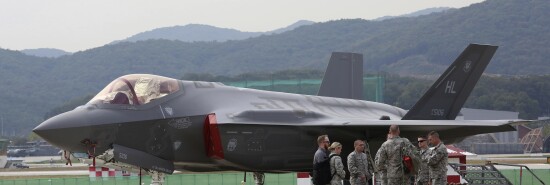
Lockheed Martin-funded writer says F-35 is the best. It isn’t
Tom Rogan
Video Embed
Writing for 19FortyFive, Daniel Goure declares that The Week’s Joel Mathis and other critics of the F-35 fighter jet are “dead wrong” about Lockheed Martin’s aircraft.
Calling for increased purchases of the aircraft, Goure leaves out that the Lexington Institute, where he serves as vice president, receives funding from Lockheed Martin and many other major defense contractors. He suggests that most Pentagon procurement programs have “teething problems,” the F-35 being “no exception.” This is the equivalent of saying that most leaders have egos and Donald Trump is no exception.
HOUSE OVERSIGHT REPUBLICANS DEMAND ACCOUNTING OF US AID TO UKRAINE
Even so, the deeper problem with Goure’s argument is that it offers a mismatch between what the nation needs from its strike fighter force and what the F-35 can credibly offer.
Goure is right that the F-35 fighter jet is well suited to defeating a prospective Russian invasion of NATO member states. Many NATO member states have already purchased the jet, meaning that forces from different nations can pool their maintenance, training, and operational efforts. The relative scale and disposition of NATO and Russian air forces, and the saturated Russian air defense forces likely to face NATO in any conflict, mean that NATO F-35s are well placed to seize and hold early air superiority in any war with Russia.
But the F-35’s problem is China. And when it comes to U.S. military planning and resourcing, the priorities should be China, China, China, Russia, China, in that order.
Xi Jinping has made his subjugation of Taiwan a near-term test of destiny, and he is rapidly shaping his military with that in mind. Goure implies that the F-35 can grapple with China because of its advanced sensors and ability to share data across other military assets. He notes that “the F-35 achieved a kill ratio of 15 to one” in 2017 combat air exercises and that it “offers unparalleled capabilities.”
That sounds good — and indeed, Goure’s argument would win out, were the F-35 able to carry 15 missiles and fight for long durations without needing to refuel. But it can’t.
Without sacrificing its stealth profile, the jet’s weapons payload is limited to just four missiles. To put it lightly, this is a problem. After all, U.S. military pilots will likely be severely outnumbered by People’s Liberation Army aircraft, air defense warships, and other assets during any war over Taiwan. Those PLA assets will also have far less distance to travel to rearm, refuel, and repair. The PLA’s anti-ship ballistic missiles will also force the U.S. Navy’s aircraft carriers to operate at long range from Taiwan, further exacerbating the F-35’s combat range shortcomings. To fight China, the U.S. military needs aircraft that have long ranges and are loaded for bear. That’s the F-15EX, not the F-35.
Another problem with Goure’s argument is relevant given Congressional scrutiny over defense spending. Goure claims that “While more sophisticated than any deployed fighter, the F-35 is also more cost-effective to operate and maintain.”
But that’s a stretch. Lockheed Martin’s F-22 jet is by far the world’s best air superiority fighter. But accounting for per-aircraft life expectancy and maintenance costs, the F-35 is significantly more expensive than other aircraft, such as the F-15EX. We need to start being honest about what the nation needs, not what defense contractors want it to pretend it needs. If we fail that test, America may lose the next major war and the post-1945 democratic international order with it.
